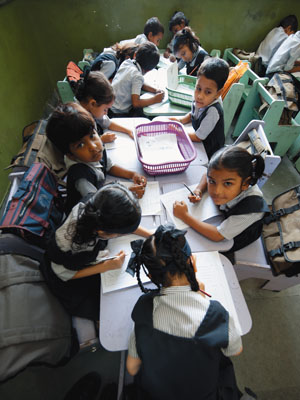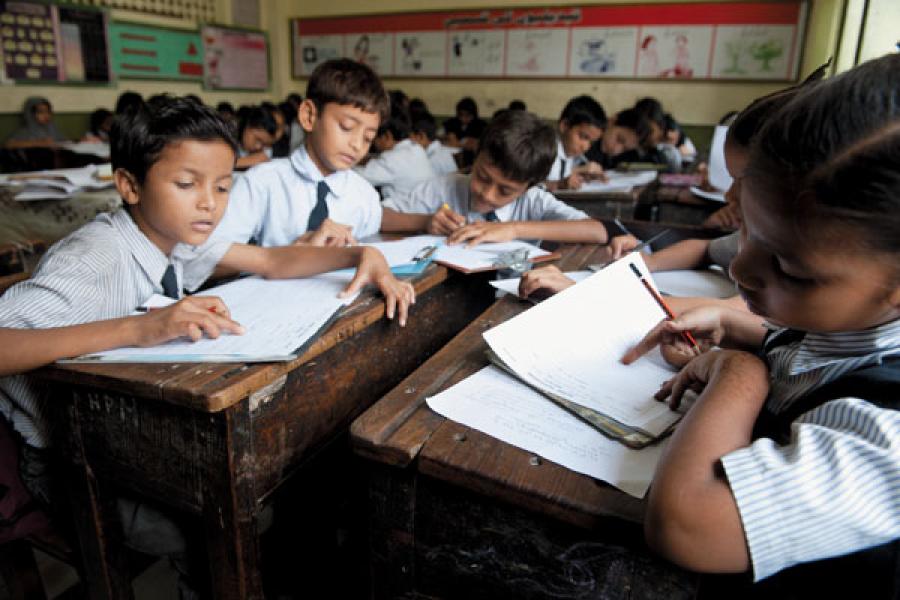
Municipal Schools in Mumbai Focus on Better Learning
Municipal schools are not best known for the quality of learning they impart. But for the first time, Mumbaiís civic administration is trying to change that
The children, in blue and white uniforms, sit in groups of six, with their desks arranged in circles. They compare the sheets they hold and amid whispers and giggles, they tick off the right answers with pencils. This is how the students of Class 1 at the Hutatma Prabhakar Keluskar (HPK) Urdu Medium School 2 in Kurla answer their evaluation questions.
“They are not scared of exams anymore,” says the headmistress Chand Sultana with a smile. This is the method that the Brihanmumbai Municipal Corporation (BMC) is betting on to improve the standard of learning and teaching in its 1,400 schools in Mumbai — an initiative that is the first of its kind in more ways than one.
This is the first instance of a municipal authority taking up an initiative to improve learning levels in its schools, with interventions at various levels. It is also the first time that a municipal authority, UNICEF, McKinsey & Company and a range of not-for-profit and for-profit organisations are pooling in their funds, resources, skills and infrastructure to implement a programme of this nature.
Education is a complex subject and the government is the largest service provider in the sector. If these methods meet with success in Mumbai’s municipal schools, they can be replicated in other government and private schools, across different languages of instruction. This can prove to be the means to raise learning standards that have been blunted by years of rote learning and ineffective teaching methods.
“Legislations like the Right to Education focus on infrastructure and enrolment. They don’t focus on the standard of education,” says Ashish Kumar Singh, secretary to the chief minister of Maharashtra. Singh was the person who spearheaded the School Excellence Programme in BMC schools during his tenure as assistant municipal commissioner between September 2009 and November 2010. “This programme is about improving what happens within the four walls of a classroom, rather than simply building more of those four walls.”
Given the bureaucracy within the municipal education system in Mumbai, this is a very ambitious attempt to get all the moving parts in sync and work together.
Tejinder Sadhu, the UNICEF head for Maharashtra says that the challenge is not to provide funds for the programme, but to ensure that the system is strengthened from within. He adds that in India, this is the largest urban programme that the UNICEF is involved with.
Locating the Problem
To start with, it is important to understand the reason why the quality of teaching is so bad in the first place. “It would be wrong if I say that the state of the BMC schools was pitiable and that nothing worked. On the contrary, there were some good things happening in these schools when I visited them,” says Singh. “It seemed that what the teachers were waiting for was guidance and encouragement.”
There were decent classrooms, but there was no proper monitoring system. Also, if a few schools were doing well, there was no way in which their methods could be scaled up to include a larger number of schools.
“When we conducted our baseline assessment in primary and upper primary classes in October, we found that rote learning among children was the reason they lacked a better understanding of very fundamental concepts,” says Sandeep Saha, vice president, strategic relationships, at Education Initiatives, an organisation that has been given the task of conducting baseline assessments to understand the students’ current level of learning. “There [was] also a high drop-out rate among 10 and 11-year-olds.”
Saha says that simply providing free or subsidised education — as the government aims to do through the Right to Education and schemes such as the Mid-day Meal — are not enough to keep bringing the kids back to school. The quality of education has to go hand-in-hand with access to it.
Teachers have often claimed that the administrative work load in the school does not leave them with enough time to teach. Singh and Saha both feel that this is merely an excuse and not a valid reason for poor teaching standards.
Money has never been the problem in implementing better learning methods. “The cost of running this programme over three years is about Rs. 100 crore. The BMC’s annual education budget is Rs. 1,641 crore. Therefore, it is not a significant amount of the budget that has to be diverted for the programme,” says Singh. Saha feels that the amount of money spent on a child has little to do with how well he learns. “Bhutan’s expenditure on a single child is much less than India’s, but their learning levels are much higher,” he says.
Getting Down To It
The mandate of the School Excellence Programme was to deal with the primary section of the school. Implementing the programme required interventions at five levels: There had to be a change in pedagogy (teaching methods), with the focus shifting to group- and activity-based learning; teachers had to be trained in this new method; school headmasters had to be trained in the role of mentors and leaders and not just administration roles; the administrative workload on teachers had to be reduced; and an evaluation had to be conducted on the students’ understanding levels.
Each partner has been brought onboard with a specific task. Kaivalya Education Foundation trains headmasters; Naandi Foundation develops the pedagogy and teacher training methods for Urdu medium schools while Rishi Valley Education Resources does the same for Hindi and Marathi medium schools; McKinsey is partnering with the municipal authority on overall programme design and programme management.
UNICEF signed a memorandum of understanding with the BMC last November, bringing $1.5 million to fund the first year of the project.
The Urdu medium school in Kurla is one of the 100 schools that have been selected as part of the pilot project that was rolled out in January 2010. As part of the pilot programme, 100 teachers and 30 headmasters from BMC’s Hindi, Marathi and Urdu medium schools have been trained to be collaborators (called sahyogis) in pedagogy and in group- and activity-based teaching methods between September and October last year, and the first classes in the new method began to be conducted in January 2011. While the teacher collaborators will train 1,000 more teachers in teaching methods, the headmaster collaborators will train about 120 headmasters.
Assessments of students are through a continuous system of evaluation that is conducted at the end of every month, based on what students recall from what they have been taught in that month. This adds up to 30 percent of the total marks, while the rest is simply by constantly observing the students learning and understanding.
“The methods of intervention at different levels that the BMC has employed are not new. They are tried and tested methods that have shown results in other places. The Tamil Nadu government, for instance, has implemented a similar programme for the past two-three years. But this is perhaps the first instance of a municipal authority adopting these methods,” says Anurag Behar, vice chancellor of the Azim Premji University. “The trick lies in
executing such projects.”
And this is where the BMC might be getting it right. “There have been programmes launched by the state government [earlier as well]. There was one in 1986 called the Dharak project, and another called Minimum Learning Level in 1993. But there was no monitoring of these projects and they ended up being useless,” says Asrar. “For this programme, we have to constantly assess the performance of students and teachers on numerous parameters and send detailed feedback to the Naandi Foundation. There is a very strict monitoring system in place and that is the only way to ensure that a programme is being executed properly.”
The BMC has an elaborate network of officers and supervisors whose job is to check on municipal schools. However their visits have usually been limited to cursory glances at paperwork and peeks into classrooms. This lack of real supervision is the reason why previous programmes have been ineffective.
Navigating Stumbling Blocks
While Ashish Kumar Singh says that there has hardly been any resistance in the implementation of this programme, the ground reality is a little different.
“There has been some resistance to the programme, although the numbers are not large,” says Pallavi Gandhalikar, who is part of the headmaster training programme from Kaivalya Education Foundation. “There are some who feel that they have been doing this for many years and there is not much that is new to learn. It is important to make them feel that they are equal stakeholders in this programme.”
Asrar agrees. “Teachers are also sceptical about this programme because of their past experiences. They have seen other government programmes being implemented only on paper and think that this one too will run its course and peter out. So [they wonder why they should] put in any effort?” says Asrar.
But Chand Sultana, headmistress of HPK Urdu Medium School 2, is more optimistic: “Under the Right to Education, children have to be promoted from one class to the next regardless of their performance. This has put a greater responsibility on teachers and headmasters to ensure the students have learnt their lessons and don’t reach Class 8 without any knowledge.”
But how these methods will be implemented at the secondary level of education is something that is yet to be worked out or implemented. Taking their board exams or competitive exams after that is a completely different ball game from sitting in groups and answering questions by discussing them in class.
“We believe that getting the primary grounding right is the most important aspect of education. Rishi Valley [ a residential school in South India] has proven that a firm grounding is good enough to prepare children for any competitive exam at higher levels,” says Anoop Rao, national director of education, Naandi Foundation. “There are two aspects that we will have to monitor: The changes that are being brought about and the sustainability of the programme. And the pilot project will let us see how this progresses.”
What Lies Ahead
Anurag Behar of Azim Premji University says that the methods the BMC is employing take years to bear fruit. This is something that the other stakeholders in the project agree on. It will only be through a few years of implementation that the learning and understanding levels of primary school children can be improved, not over a term or two.
The current municipal commissioner was not contactable. However, the plan right now is to take intermittent assessments and see if the pilot programme is being implemented properly. There will be a gradual scaling up of the programme, to include a total of 250 to 300 schools by the beginning of the 2011-2012 academic year in June.
“We are using [the latest methods] to implement this programme and will take time to bring all the schools up to the same level,” says UNICEF’s Tejinder Sadhu. “Bringing about changes in the education system is difficult and requires a lot of patience. After all, a child will take five years to complete five years in school. He cannot take less.”
At the end of the 2011 academic year, there will be an overall assessment taken to see what kind of roles the partners will need to continue in — if at all. UNICEF too will decide if it wants to continue funding the programme or whether it will be able to sustain itself.
(This story appears in the 06 May, 2011 issue of Forbes India. To visit our Archives, click here.)

















